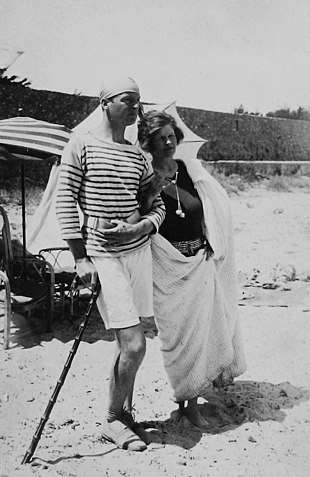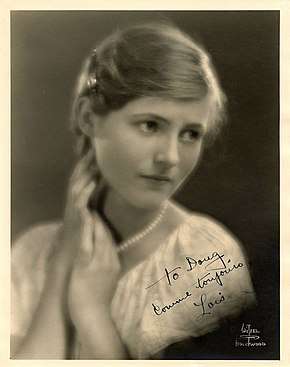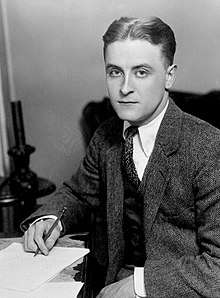Tender Is the Night
Tender Is the Night is the fourth and final novel completed by American writer F. Scott Fitzgerald. It was first published in Scribner's Magazine between January and April 1934 in four issues. The title is taken from the poem "Ode to a Nightingale" by John Keats.
.jpg) First edition | |
| Author | F. Scott Fitzgerald |
|---|---|
| Country | United States |
| Language | English |
| Genre | Novel |
| Publisher | Charles Scribner's Sons |
Publication date | Serialized Jan–Apr 1934; book Apr 1934 |
| Preceded by | The Great Gatsby (1925) |
| Followed by | The Last Tycoon (1941, publ. posthumously) |
In 1932, Fitzgerald's wife Zelda Sayre Fitzgerald was hospitalized for schizophrenia in Baltimore, Maryland. The author rented the La Paix estate in the suburb of Towson to be close to his wife; at this estate he would begin a novel on the rise and fall of Dick Diver, a promising young psychiatrist, and his wife, Nicole, who is also one of his patients. It was Fitzgerald's first novel in nine years and the last that he would complete. The early 1930s, when Fitzgerald conceived the book, were the darkest years of his life, and the novel's bleakness reflects his own experiences. The novel almost mirrors the events of Fitzgerald and Zelda's lives, as characters are pulled out of and put back into mental care, and the male figure, Dick Diver, starts his descent into alcoholism. While working on the book, Fitzgerald was beset with financial difficulties. He borrowed money from both his editor and his agent and wrote short stories for commercial magazines.
Two versions of the novel are in print.[1] The first version, published in 1934, uses flashbacks; the second, revised version, prepared by Fitzgerald's friend and noted critic Malcolm Cowley on the basis of notes for a revision left by Fitzgerald, is ordered chronologically and was first published posthumously in 1948.[1] Critics have suggested that Cowley's revision was undertaken due to negative reviews of the temporal structure of the first version of the book.
Fitzgerald considered Tender Is the Night to be his greatest work.[2] Although it received a tepid response upon release, it has grown in acclaim over the years and is widely regarded as among Fitzgerald's best books.[3] In 1998, the Modern Library ranked the novel 28th on its list of the 100 best English-language novels of the 20th century.[4]
Plot summary
Dick and Nicole Diver are a glamorous couple who rent a villa in the South of France and surround themselves with a circle of friends, mainly Americans. Also staying at the nearby resort are Rosemary Hoyt, a young 17-year-old actress, and her mother. Rosemary becomes infatuated with Dick and also becomes close to Nicole. Dick toys with the idea of having an affair with Rosemary.
Rosemary senses something is wrong with the couple, which is brought to light when one of the guests at a party reports having seen something strange in a bathroom. Tommy Barban, another guest, comes loyally to the defense of the Divers. The action involves various other friends, including the Norths, a frequent occurrence being the drunken behavior of Abe North. The story becomes complicated when Jules Peterson, a black man, is murdered in Paris and ends up in Rosemary's bed at the hotel, a situation which could destroy Rosemary's career. Dick moves the blood-soaked body out of the room to cover up any implied relationship between Rosemary and Peterson.
It is revealed that Captain Dick Diver, a promising young doctor and psychiatrist, while visiting his friend Franz, also a psychiatrist, had earlier met a stunning teenage patient with an especially complex case of neuroses. The patient is Nicole, whose sexual abuse by her father is suggested as the cause of her breakdown. Over a period of time they exchange letters. With permission of Franz and his superior, who believe that Dick's friendship benefits Nicole's wellbeing, they start seeing each other. As her treatment progresses, Nicole becomes infatuated with Dick, who in turn develops Florence Nightingale syndrome. He eventually determines to marry Nicole, in part, as a means of providing her with lasting emotional stability. Strong objections are raised by Nicole's sister, who believes Dick is marrying Nicole because of her status as an heiress.
Dick is offered by Franz a partnership in a Swiss psychiatric clinic, and Nicole pays for the enterprise. After his father's death Dick travels to America for the burial, and then to Rome in hopes of seeing Rosemary. They start a brief affair, which ends abruptly and painfully. Dick gets into an altercation with the police, and Nicole's sister helps him to get out of jail. Dick doesn't see how he can be the same person after such a humiliation. He gradually develops a drinking problem. After this becomes an issue with the patients, Dick's ownership share of the clinic is bought out by American investors following his partner's suggestion.
Dick and Nicole's marriage breaks down when he becomes increasingly alcoholic and pines for Rosemary, who is now a successful Hollywood star. Nicole becomes increasingly aware of her independence. She distances herself from Dick as his self-confidence and friendliness turn into sarcasm and rudeness towards everyone. His constant unhappiness over what he could have been fuels his alcoholism, and Dick becomes increasingly embarrassing in social and familial situations. Nicole enters into an affair with Tommy Barban. At the end of the book Nicole divorces Dick and marries Barban.
Composition
Fitzgerald began working on a new novel almost immediately after the publication of The Great Gatsby in April 1925.[1] His original plan was to tell the story of Francis Melarkey, a young Hollywood technician traveling on the French Riviera with his domineering mother. Francis was to fall in with a group of glittering and charming wealthy American expatriates (based on Gerald and Sara Murphy and some of their friends) and gradually disintegrate, ultimately killing his mother. Fitzgerald originally intended to call the novel "World's Fair," but also considered "Our Type" and "The Boy Who Killed His Mother." The characters based on the Murphys were originally named Seth and Dinah Piper, and Francis was intended to fall in love with Dinah – an event that would help to precipitate his disintegration.
Fitzgerald wrote several chapters for this version of the novel in 1925 and 1926, but was unable to finish it. Nearly all of what he wrote ultimately made it into the finished work in altered form. Francis's arrival on the Riviera with his mother, and his introduction to the world of the Pipers, was eventually transposed into Rosemary Hoyt's arrival with her mother, and her introduction to the world of Dick and Nicole Diver. Characters created in this early version survived into the final novel, particularly Abe and Mary North (originally Grant) and the McKiscos. Several incidents such as Rosemary's arrival and early scenes on the beach, her visit to the Riviera movie studio, and the dinner party at the Divers' villa all appeared in this original version, but with Francis in the role of the wide-eyed outsider that would later be filled by Rosemary. Also, the sequence in which a drunken Dick is beaten by police in Rome was written in this first version as well (with Francis as the beaten victim); this was based on a real incident that happened to Fitzgerald in Rome in 1924.
After a certain point, Fitzgerald became stymied with the novel. He and Zelda (and Scottie) returned to the United States after several years in Europe, and in 1927 Scott went to Hollywood to write for the movies. There he met Lois Moran, a beautiful actress in her late teens, with whom he had an intense relationship. Moran became the inspiration for the character of Rosemary Hoyt. Fitzgerald supported himself and his family in the late 1920s with his highly lucrative short-story output (particularly for the Saturday Evening Post), but was haunted by his inability to progress on the novel. Around 1929 he tried a new angle on the material, starting over with a shipboard story about a Hollywood director and his wife (Lew and Nicole Kelly) and a young actress named Rosemary. But Fitzgerald apparently completed only two chapters of this version.
By 1930 the Fitzgeralds were again living in Europe. Zelda had her first nervous breakdown in early 1930 and was institutionalized in Switzerland. It soon became apparent that she would never fully recover. Fitzgerald's father died in 1931, an event that was written into the final novel as Dick's father's death. Devastated by these blows (and by his own unrelenting alcoholism), Fitzgerald had settled in suburban Baltimore by 1932 and had finally decided what he was going to write his novel about – a man of almost limitless potential who makes the fatal decision to marry a beautiful but mentally ill woman, and who ultimately sinks into despair and alcoholism when their doomed marriage fails.
Fitzgerald wrote the final version of Tender Is the Night in 1932 and 1933, while renting the La Paix estate from Baltimore architect Bayard Turnbull. He salvaged almost everything he had written for the Melarkey draft of the novel in some form or other and also borrowed ideas, images, and phrases from many short stories he had written in the years since completing The Great Gatsby. Ultimately, he poured everything he had into Tender – his feelings about his own wasted talent and (self-perceived) professional failure and stagnation; his feelings about his parents (who on a symbolic level provided much of the inspiration for Dick and Nicole Diver); about his marriage, and Zelda's illness, and psychiatry (about which he had learned a great deal during her treatment); about his affair with Lois Moran, and Zelda's with the French aviator Edouard Jozan (paralleled in the relationship between Nicole Diver and Tommy Barban).
The book was completed in the fall of 1933 and serialized in four installments in Scribner's Magazine before its publication on April 12, 1934.[3]
Appearances in other works
References in film
Tender Is the Night has appeared in several films. It first appeared in Michelangelo Antonioni's 1960 film L'avventura as the book Anna was reading before she disappeared. It is also seen in Wim Wenders' film Alice in den Städten (1973—in English, Alice in the Cities) on the coffee table of Vogel's depressed girlfriend. The use of the book in the latter film may have been inspired by actress Lois Moran, who was the basis for the character of Rosemary Hoyt in Fitzgerald's novel and played an "Airport Hostess" in Wenders' movie.[5]
The Coen Brothers' 1991 film Barton Fink contains a similar scene in which the protagonist awakes in a hotel room next to a murdered body, and recruits a friend to hide the body in order to cover up an affair.
Film, TV and stage adaptations
The film Tender Is the Night (1962), based on the novel, starred Jason Robards and Jennifer Jones as the Divers. The song "Tender Is the Night" from the movie soundtrack was nominated for the 1962 Academy Awards for Best Song.
A television mini-series of the book, with script by Dennis Potter, music by Richard Rodney Bennett, and with Mary Steenburgen and Peter Strauss as Nicole and Dick, was made by the BBC and shown in 1985 by the BBC in the United Kingdom, the Canadian Broadcasting Corporation in Canada, and Showtime in the United States.
A stage adaptation by Simon Levy, with permission of the Fitzgerald Estate, was produced at The Fountain Theatre, Los Angeles in 1995. It won the PEN Literary Award in Drama and several other awards.[6]
Boris Eifman's 2015 ballet Up and Down is based loosely on the novel.[7]
Critical reception
Fitzgerald considered the novel to be his masterwork and expected it to eclipse the popularity and acclaim of his earlier novels, particularly The Great Gatsby.[8] However, it was instead met with mixed reviews and lukewarm sales. This greatly distressed Fitzgerald and continued to puzzle him for the remainder of his life.[1][9] In its first three months of release, Tender Is the Night sold 12,000 copies compared to This Side of Paradise, which sold over 50,000 during a similar frame.[1] While it received a handful of extremely positive reviews, the prevailing consensus was that its quintessentially 1920s style and subject matter was no longer modern or of sufficient interest to readers.[1]
Legacy and modern analysis
Since its initial release, Tender Is the Night's critical reputation has steadily grown.[10] Modern critics have described it as "an exquisitely crafted piece of fiction"[10] and "one of the greatest American novels."[2] It is now widely regarded as among Fitzgerald's most accomplished works, with some, particularly critics outside the US, agreeing with the author's own assessment that it surpasses The Great Gatsby.[3] Many theories have arisen as to why the novel did not receive a warmer reception upon release. Ernest Hemingway remarked that, in retrospect, "Tender Is the Night gets better and better" and felt that both he and critics had initially only been interested in dissecting its weaknesses, rather than giving due credit to its merits.[11] Hemingway and others have argued that such overly harsh criticism stemmed from superficial readings of the material, and Depression-era America's reaction to Fitzgerald's status as a symbol of Jazz Age excess. [12][13] Some critics have argued the novel to be a strongly feminist work, and feel that the conservative patriarchal attitudes of the 1930s were largely responsible for initial dismissal.[14] Academics have noted the strong parallels between Dick Diver and Jay Gatsby,[15] with many regarding the novel, and particularly Diver's character, as Fitzgerald's most emotionally and psychologically complex work.[16] Anne Daniel, writing for The Huffington Post, lamented the book's forgotten status in mainstream culture and commented that readers who loved The Great Gatsby would inevitably come to love Tender Is the Night even more.[17]
Christian Messenger argues that Fitzgerald's book hinges on the sustaining sentimental fragments: “On an aesthetic level, Fitzgerald’s working through of sentiment’s broken premises and rhetoric in Tender heralds a triumph of modernism in his attempt to sustain his sentimental fragments and allegiances in new forms.”[18] He also calls it "F Scott Fitzgerald's richest novel, replete with vivid characters, gorgeous prose, and shocking scenes," and calls attention to Slavoj Žižek's use of the book to illustrate the nonlinear nature of experience.[19]
Honors
In 1998, the Modern Library included the novel at #28 on its list of the 100 best English-language novels of the 20th century.[4] Radcliffe later included it at #62 in its rival list.[20] NPR included it at #69 on its 2009 list titled 100 Years, 100 Novels.[21] In 2012 it was listed as one of the 1001 Books You Must Read Before You Die.
References
- Cowley, Malcolm (August 20, 1951). "F. Scott Fitzgerald Thought This Book Would Be the Best American Novel Of His Time". The New Republic. ISSN 0028-6583. Retrieved March 6, 2019.
- Schorer, Mark (1967). Fitzgerald's Tragic Sense. New York: Collier. p. 170.
- Bruccoli, Matthew J. (1963). The Composition of Tender Is the Night. United States: University of Pittsburgh Press. ISBN 978-0-8229-7554-0.
- "100 Best Novels". Modern Library. Retrieved June 17, 2019.
- "Alice in den Städten". Internet Movie Database. Retrieved April 23, 2010.
- Who We Are Fountain Theatre. Retrieved July 31, 2019.
- With Fitzgerald adaptation ‘Up & Down,’ Eifman succeeds on his own, melodramatic terms The Los Angeles Times. June 6, 2015. Retrieved July 31, 2019.
- Luong, Mary (April 23, 2010). "A Woman's Touch in F. Scott Fitzgerald's Tender Is the Night". Georgia State University. p. 3. Retrieved May 9, 2015.
- "F. Scott Fitzgerald". The Baltimore Literary Heritage Project. Retrieved May 9, 2015.
- Benn, Melissa (March 7, 2008). "Book of a Lifetime: Tender Is the Night, by F. Scott Fitzgerald". The Independent. Retrieved May 9, 2015.
- Bruccoli, Matthew (1967). Fitzgerald and Hemingway: A Dangerous Friendship. New York: Carroll & Graf. ISBN 0897230531.
- Stern, Milton (1970). The golden moment: the novels of F. Scott Fitzgerald. University of Illinois Press. p. 96.
- Luong 2010, p. 55.
- Luong 2010, p. 31.
- Stern 1970, p. 191.
- Kennedy, Gerald. Imagining Paris: Exile, Writing, and American Identity. New Haven: Yale University Press. pp. 192. ISBN 978-0300061024.
- Daniel, Anne (June 17, 2014). "Best Summer Read: F. Scott Fitzgerald's Tender Is the Night". The Huffington Post. Retrieved May 9, 2015.
- Tender Is the Night and F. Scott Fitzgerald's Sentimental Identities. University of Alabama. 2015. p. 17.
- Tender Is the Night and F. Scott Fitzgerald's Sentimental Identities. University of Alabama. 2015. p. 2.
- Radcliffe's Rival 100 Best Novels List Retrieved July 31, 2019.
- Meyer, Dick (May 7, 2009). "100 Years, 100 Novels, One List". National Public Radio. Retrieved June 17, 2019.
Further reading
- Bloom, Harold (1999). James, Pearl (ed.). F. Scott Fitzgerald. Broomall, Pennsylvania: Chelsea House Publishers. ISBN 978-1-4381-3993-7.
- Bruccoli, Matthew J.; Baughman, Judith S. (1996). Reader's Companion to F. Scott Fitzgerald's Tender Is the Night. Columbia: University of South Carolina Press. ISBN 978-1-57003-223-3.
- Bruccoli, Matthew J. (1963). The Composition of Tender Is the Night. United States: University of Pittsburgh Press. ISBN 978-0-8229-7554-0.
- Prigozy, Ruth, ed. (2002). "Chapter 6: "Tender Is the Night and American History"". The Cambridge Companion to F. Scott Fitzgerald. Cambridge University Press. ISBN 978-0-521-62474-9.
- Cowley, Malcolm (August 20, 1951). "F. Scott Fitzgerald Thought This Book Would Be the Best American Novel of His Time". The New Republic.
External links
| Wikiquote has quotations related to: Tender Is the Night |
- Tender Is the Night at Faded Page (Canada)
- Tender Is the Night, online text at the University of Adelaide Library.
- Tender Is the Night Map


